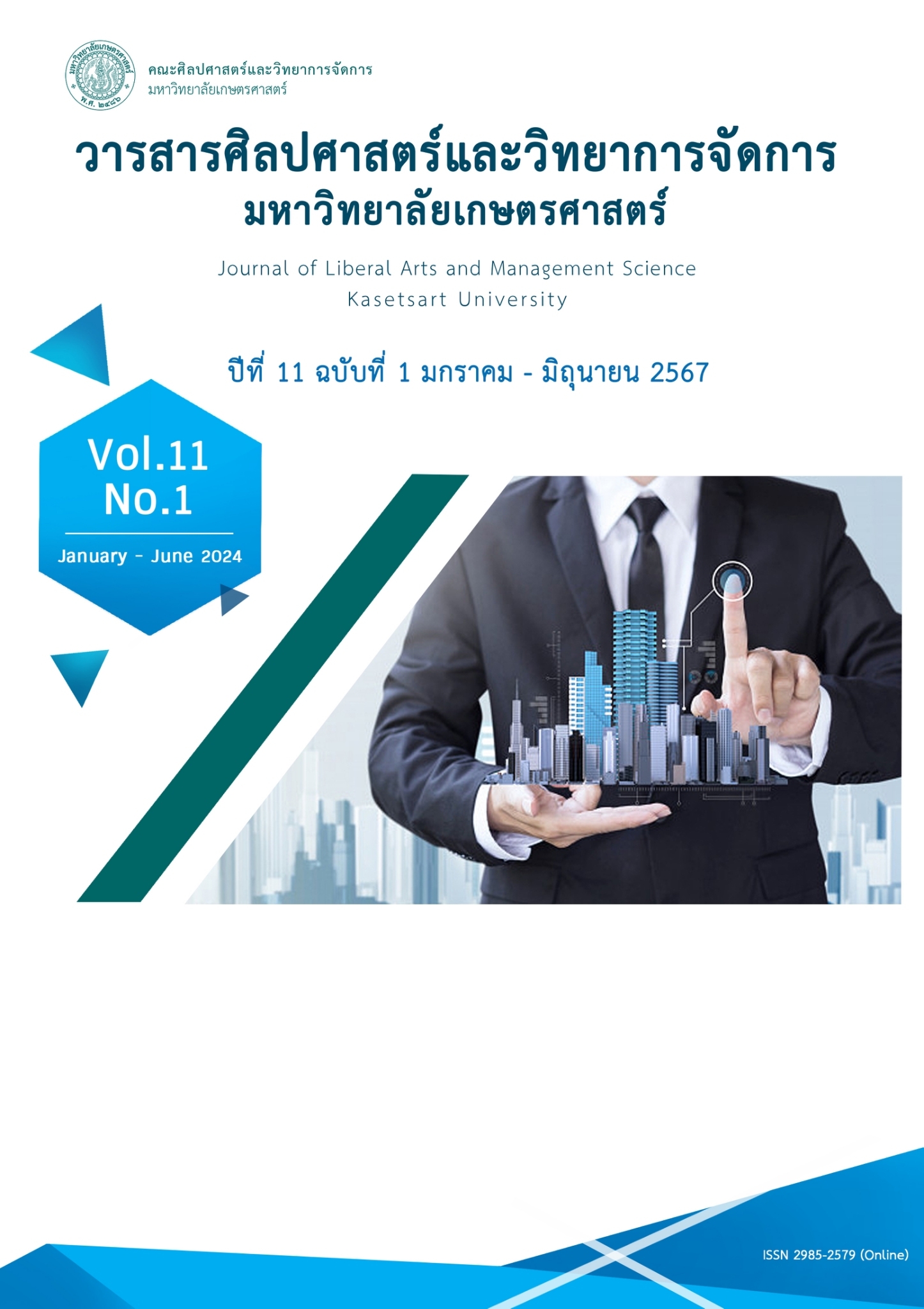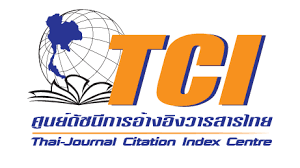รูปแบบความสัมพันธ์เชิงสาเหตุของการเปิดเผยข้อมูลด้านสิ่งแวดล้อม สังคม และ บรรษัทภิบาลกับมูลค่ากิจการของบริษัทจดทะเบียนในตลาดหลักทรัพย์แห่งประเทศไทย
คำสำคัญ:
ข้อมูลด้านสิ่งแวดล้อม สังคม และบรรษัทภิบาล , คะแนนการเปิดเผยข้อมูล , มูลค่ากิจการบทคัดย่อ
ภายใต้แนวโน้มการลงทุนอย่างยั่งยืน และการให้ความสำคัญกับคะแนนการเปิดเผยข้อมูลที่มากขึ้น การวิจัยนี้จึงมีวัตถุประสงค์เพื่อตรวจสอบความสอดคล้องของรูปแบบความสัมพันธ์เชิงสาเหตุของคะแนนการเปิดเผยข้อมูลด้านสิ่งแวดล้อม สังคม และบรรษัทภิบาล (ESG) กับมูลค่ากิจการจากหลักฐานเชิงประจักษ์ และวิเคราะห์อิทธิพลทางตรง อิทธิพลทางอ้อม และอิทธิพลรวมของปัจจัยเชิงสาเหตุในรูปแบบความสัมพันธ์เชิงสาเหตุของคะแนนการเปิดเผยข้อมูลกับมูลค่ากิจการ โดยใช้ข้อมูลงบการเงินของบริษัทจดทะเบียนที่ถูกประเมินความยั่งยืนขององค์กรในระดับสากล ตั้งแต่ปี พ.ศ. 2560 ถึง 2566 จำนวน 203 กลุ่มตัวอย่างและทำการวิเคราะห์ข้อมูลด้วยสถิติเชิงพรรณนาและสถิติเชิงอ้างอิง ผลการวิจัยพบว่า รูปแบบความสัมพันธ์เชิงสาเหตุของคะแนนการเปิดเผยข้อมูล ESG กับมูลค่ากิจการที่พัฒนาขึ้นมีความสอดคล้องกับข้อมูลเชิงประจักษ์ ใน “ระดับดี” และพบว่ามูลค่ากิจการและต้นทุนเงินทุนได้รับอิทธิพลทางตรงในทางบวกจากคะแนนการเปิดเผยข้อมูล ESG อย่างมีนัยสำคัญทางสถิติที่ระดับ 0.01 ในขณะที่มูลค่ากิจการได้รับอิทธิพลทางอ้อมในทางลบจากคะแนนการเปิดเผยข้อมูล ESG โดยมีต้นทุนเงินทุนเป็นตัวแปรส่งผ่าน ผลวิจัยสะท้อนให้เห็นถึงความไม่สอดคล้องระหว่างนโยบายด้านความยั่งยืนกับการเพิ่มความมั่นคั่งของกิจการและมีความเป็นไปได้ว่าการเปิดเผยข้อมูล ESG มีแนวโน้มที่จะใช้ต้นทุนเงินทุนสูงหากขาดความเชื่อมโยงกับกลยุทธ์ที่ชัดเจนสำหรับการตัดสินใจมีส่วนร่วมกับธุรกิจของนักลงทุนหรือข้อมูลที่เปิดเผยใช้ประโยชน์ได้น้อยอาจส่งผลต่อการสร้างผลกำไรที่ไม่ดีเท่าที่ควร
References
ณัฐพัชร์ นวลมณีฐิติ. (2563). อิทธิพลของการบริหารความเสี่ยงองค์กรที่มีต่อมูลค่ากิจการที่วัดโดยใช้ Tobin's Q ของบริษัทที่จดทะเบียนในตลาดหลักทรัพย์แห่งประเทศไทย (วิทยานิพนธ์ปรัชญาดุษฎีบัณฑิต). มหาวิทยาลัยธุรกิจบัณฑิตย์.
ปาณมน จันทบุตร, สุนีย์รัตน์ วุฒิจินดานนท์, และ อุษารัตน์ ธีรธร. (2563). การศึกษาผลกระทบที่ไม่ใช่เชิงเส้นของ CSR ต่อมูลค่าทางการตลาดของกิจการ. จุฬาลงกรณ์ธุรกิจปริทัศน์, 42(4), 22-43.
ปิยะดา เนตรสุวรรณ, มนทิพย์ ตั้งเอกจิต, และ ภูริทัต อินยา. (2565). การเปิดเผยข้อมูลความยั่งยืนของบริษัทจดทะเบียนในตลาดหลักทรัพย์แห่งประเทศไทย. วารสารวิทยาการจัดการ มหาวิทยาลัยสงขลานครินทร์, 39(1), 7-11.
พชรพล ศุขอร่าม. (2565). ผลกระทบของการเปิดเผยข้อมูลด้านสิ่งแวดล้อม สังคม และบรรษัทภิบาลที่มีต่อมูลค่าบริษัทที่จดทะเบียนในตลาดหลักทรัพย์แห่งประเทศไทย (วิทยานิพนธ์ปริญญาเศรษฐศาสตรมหาบัณฑิต). จุฬาลงกรณ์มหาวิทยาลัย.
อุภาวดี เนื่องวรรณะ. (2561). การเปิดเผยข้อมูลความรับผิดชอบต่อสังคมที่มีอิทธิพลต่อต้นทุนเงินทุนของบริษัทที่จดทะเบียนในตลาดหลักทรัพย์แห่งประเทศไทย (วิทยานิพนธ์ปรัชญาดุษฎีบัณฑิต). มหาวิทยาลัยศรีปทุม.
Akerlof, G. A. (1970). The market for “lemons”: Quality uncertainty and the market mechanism. The Quarterly Journal of Economics, 84(3). 488-500.
Alareeni, B. A., & Hamdan, A. (2020). ESG Impact on Performance of US S&P 500-Listed Firms. Corporate Governance. The International Journal of Business in Society, 20(7), 1409-1428.
Atan, R., Alam, M. M., Said, J., & Zamri, M. (2018). The Impacts of Environmental, Social, and Governance Factors on Firm Performance. Management of Environmental Quality: An International Journal, 29(2), 182-194. https://doi.org/10.1108/MEQ-03-2017-0033
Attig, N., El Ghoul, S., Guedhami, O., & Suh, J. (2013). Corporate Social Responsibility and Credit Ratings. Journal of Business Ethics, 117(4), 679-694. https://doi.org/10.1007/s10551-013-1714-2
Aydogmus, M., Gulay, G., & Ergun, K. (2022). Impact of ESG Performance on Firm Value and Profitability. Borsa Istanbul Review, 22(2), 119-127. http://dx.doi.org/10.1016/j.bir.2022.11.006
Balatbat, M., Siew, R., & Carmichael, D. (2012). ESG scores and its influence on firm performance: Australian evidence. In Australian school of business school of accounting, school of accounting seminar series semester (p. 1-30). University of New South Wales.
Barbaric, M. (2021). ESG Scores and Financial Performance of Swedish-listed Companies– Is there a link? (Master's thesis). Jönköping University.
Barnard, C. I. (1938). The Functions of the Executive. Cambridge: Harvard University Press.
Ben-Eli, M. U. (2018). Sustainability: definition and five core principles, a systems perspective. Sustainability Science, 13(5), 1337-1343. https://doi.org/10.1007/s11625-018-0564-3
Berntsson, W. (2019). The Impact of ESG Score on Firm's Cost of Capital and Riskiness (Master’s thesis). University of Gothenburg.
Britton, N. (2021). What is ESG and why corporate tax departments should care. Thomson Reuters. Retrieved 1 May 2022, from https://www.thomsonreuters.com/en-us/posts/tax-and-accounting/esg-corporate-tax-departments/
Broadstock, D. C., Chan, K., Cheng, L. T., & Wang, X. (2021). The role of ESG performance during times of financial crisis: Evidence from COVID-19 in China. Finance Research Letters, 38(1), 101716. https://doi.org/10.1016/j.frl.2020.101716
Brown, J & Tregidga, H. (2017). Re-Politicizing Social and Environmental Accounting Through Ranciere: On the Value of Dissensus. Accounting, Organizations and Society, 61, 1-21. https://doi.org/10.1016/j.aos.2017.08.002
Campbell, D., Craven, B. & Shrives, P. (2003). Voluntary Social Reporting in Three FTSE Sectors: A Comment on Perception and Legitimacy. Accounting, Auditing & Accountability Journal, 16(4), 558-581. https://doi.org/10.1108/09513570310492308
Cardamone, P., Carnevale, C., & Giunta, F. (2012). The Value Relevance of Social Reporting: Evidence from Listed Italian Companies. Journal of Applied Accounting Research, 13(3), 255. https://doi.org/10.1108/09675421211281326
Chen, L., Feldmann, A., & Tang, O. (2015). The relationship between disclosures of corporate social performance and financial performance: Evidences from GRI reports in manufacturing industry. International Journal of Production Economics, 170(PB), 445-456.
Chung, K. H., & Pruitt, S. W. (1994). A Simple Approximation of Tobin’s Q. Financial Management, 23(3), 70-74.
Crisostomo, V. L., Freire, F. d., & Vasconcellos, F. C. (2011). Corporate social responsibility, firm value and financial performance in Brazil. Social responsibility journal, 7(2), 295-309. http://dx.doi.org/10.1108/17471111111141549
Deegan, C. (2002). Introduction: The legitimising effect of social and environmental disclosures–a theoretical foundation. Accounting, auditing & accountability journal, 15(3), 282-311. https://doi.org/10.1108/09513570210435852
Deng, X., Kang, J. K., & Low, B. S. (2013). Corporate social responsibility and stakeholder value maximization: Evidence from mergers. Journal of financial Economics, 110(1), 87-109. https://doi.org/10.1016/j.jfineco.2013.04.014
Ding, A., Daugaard, D., & Linnenluecke, M. K. (2020). The Future Trajectory for Environmental Finance: Planetary Boundaries and Environmental, Social and Governance Analysis. Accounting & Finance, 60(1), 3–14. https://doi.org/10.1111/acfi.12599
Farooque, O. A., & Ahulu, H. (2015). Environmental Reporting in the UK, Australia, and South African Multinational Companies. Journal of Developing Areas, 49(6), 103-118. https://doi.org/10.1353/jda.2015.0117
Flammer, C. (2015). Does corporate social responsibility lead to superior financial performance?. A regression discontinuity approach. Management science, 61(11), 2549-2568. https://doi.org/10.1287/mnsc.2014.2038
Freeman, R. E. (1984). Strategic Management: A Stakeholder Approach. New York: Cambridge University Press.
Freeman, R. E., Dmytriyev, S., & Phillips, R. (2017). Stakeholder Theory and the Resource-Based View. Journal of Management, 47(5), 1-14.
Friede, G., Busch, T., & Bassen, A. (2015). ESG and financial performance: aggregated evidence from more than 2000 empirical studies. Journal of sustainable finance & investment, 5(4), 210-233. https://doi.org/10.1080/20430795.2015.1118917
Friedman, M. (2007). The social responsibility of business is to increase its profits. In Corporate ethics and corporate governance (p. 173-178). Heidelberg: Springer-Verlag Berlin.
Global Reporting Initiative. (2015). G4 Sustainability Reporting Guidelines. Retrieved 1 May 2023, from https://commdev.org/publications/global-reporting-initiative-g4-sustainability-reporting-guidelines-reporting-principles-and-standard-disclosures/
Governance & Accountability Institute. (2023). New Research Shows Mid-Cap U.S. Public Companies Closing Sustainability Reporting Gap in 2022. Retrieved 1 May 2023, from https://www.ga-institute.com/research/research/sustainability-reporting-trends/2023-sustainability-reporting-in-focus.html
Graff Zivin, J., & Small, A. (2005). A Modigliani-Miller theory of altruistic corporate social responsibility. The B.E. Journal of Economic Analysis & Policy, 5(1), 0000101515153806531369. https://doi.org/10.1515/1538-0653.1369
Hair Jr., J. F., Hult, G. T. M., Ringle, C. M., Sarstedt, M., Danks, N. P., Ray, S. et al. (2021). Evaluation of Reflective Measurement Models. In Partial Least Squares Structural Equation Modeling (PLS-SEM) Using R. Classroom Companion: Business (p. 75-90). Heidelberg: Springer.
Hall, B. H., Cumminq, C., Laderman, E. S., & Mundy, J. (1988). The R&D master file documentation. Retrieved 1 May 2023, from https://www.nber.org/system/files/working_papers/t0072/t0072.pdf
Harabida, M., & Radi, B. (2021). The Impact of Membership in a Socially Responsible Index on Stock Prices: A Systemic Review of the Literature. Journal of Economics, Finance and Management Studies, 4(6), 743-752. https://doi.org/10.47191/jefms/v4-i6-09
Hogan, K., Olson, G. T., & Sharma, R. (2014). The role of corporate philanthropy on ratings of corporate social responsibility and shareholder return. Journal of Leadership, Accountability and Ethics, 11(3), 108–125.
Jensen, M. C., & Meckling, W. H. (1976). Theory of the firm: Managerial behavior, agency costs and ownership structure. Journal of Financial Economics, 3(4), 305-360.
Khan, N., Malik, Q. A., Saghir, A., Rasheed, M. H., & Husnain, M. (2021). Does corporate social responsibility reduce financial distress? Evidence from emerging economy. Management Science Letters, 8(11), 2225-2232.
Kim, S., & Park, H. (2013). Effects of Various Characteristics of Social Commerce on Consumers’ Trust and Trust Performance. International Journal of Information Management, 33(2), 318–332. https://doi.org/10.1016/j.ijinfomgt.2012.11.006
Lewellen, W. G., & Badrinath, S. G. (1997). On the measurement of Tobin's q. Journal of financial economics, 44(1), 77-122. https://doi.org/10.1016/S0304-405X(96)00013-X
Lindenberg, E. B., & Ross, S. A. (1981). Tobin's Q Ratio and Industrial Organization. Journal of business, 54(1), 1-32.
Love, C. & Petchchedchoo, P. (2019). Environment, Social and Governance Performance (ESG) with Earnings Quality. Suthiparithat. 33(106). 179–194.
Lu, W. M., Wang, W. K., & Lee, H. L. (2013). The relationship between corporate social responsibility and corporate performance: Evidence from the US semiconductor industry. International Journal of Production Research, 51(19), 5683-5695. http://dx.doi.org/10.1080/00207543.2013.776186
Mackey, A., Mackey, T. B., & Barney, J. B. (2007). Corporate social responsibility and firm performance: Investor preferences and corporate strategies. Academy of management review, 32(3), 817-835.
Magnanelli, B. S., & Izzo, M. F. (2017). Corporate Social Performance and Cost of Debt: The Relationship. Social Responsibility Journal, 13(2), 250-265. https://doi.org/10.1108/SRJ-06-2016-0103
Middha, D., & Doshi, Y. S. (2019). Relationship Between ESG and Financial Performance of Publicly Listed Firms on the S&P 500 (Master's Thesis). Simon Fraser University.
Ng, A. C., & Rezaee, Z. (2015). Business Sustainability Performance and Cost of Equity capital. Journal of Corporate Finance, 34, 128-149. https://doi.org/10.1016/j.jcorpfin.2015.08.003
Peng, L. S., & Isa, M. (2020). Environmental, social and governance (ESG) practices and performance in Shariah firms: agency or stakeholder theory?. Asian Academy of Management Journal of Accounting & Finance, 16(1). 1-34.
Pu, G. (2023). A non-linear assessment of ESG and firm performance relationship: evidence from China. Economic research-Ekonomska istraživanja, 36(1). 2113336. https://doi.org/10.1080/1331677X.2022.2113336
Raimo, N., Caragnano, A., Mariani, M., & Vitolla, F. (2022). Integrated reporting quality and cost of debt financing. Journal of Applied Accounting Research, 23(1), 122-138. https://doi.org/10.1108/JAAR-04-2021-0097
Ramirez, A. G., Monsalve, J., González-Ruiz, J. D., Almonacid, P., & Peña, A. (2022). Relationship Between the Cost of Capital and Environmental, Social, and Governance Scores: Evidence from Latin America. Sustainability, 14(9), 5012. https://doi.org/10.3390/su14095012
Shad, M. K., Lai, F. W., Shamim, A., & McShane, M. (2020). The efficacy of sustainability reporting towards cost of debt and equity reduction. Environmental Science and Pollution Research, 27, 22511-22522. https://doi.org/10.1007/s11356-020-08398-9
Sharpe, W. F. (1964). Capital Asset Prices: A Theory of Market Equilibrium under Conditions of Risk. Journal of Finance, 19(3), 425-442. https://doi.org/10.1111/j.1540-6261.1964.tb02865.x
Spence, M. (1973) Job Market Signaling. Quarterly Journal of Economics, 87, 355-373. https://doi.org/10.2307/1882010
Suchman, M. C. (1995). Managing legitimacy: Strategic and institutional approaches. Academy of management review, 20(3), 571-610. https://doi.org/10.2307/258788
Tang, Z., Hull, C. E., & Rothenberg, S. (2012). How corporate social responsibility engagement strategy moderates the CSR–financial performance relationship. Journal of management Studies, 49(7), 1274-1303. https://doi.org/10.1111/j.1467-6486.2012.01068.x
Van Brecht, D., Maga, A., Luciani, K., Sahakijpicharn, D., & Semmerling, A. (2018). Exploring the link between Environmental, Social and Governance (ESG) disclosure and market value of the firm: evidence from Thai listed companies. ASEAN Journal of Management & Innovation, 5(2), 95-106.
Wong, W. C., Batten, J. A., Mohamed-Arshad, S. B., Nordin, S., & Adzis, A. A. (2021). Does ESG certification add firm value?. Finance Research Letters, 39, 101593. https://doi.org/10.1016/j.frl.2020.101593
Yordudom, T; Suttipun, M. (2020). The Influence of ESG Disclosures on Firm Value in Thailand. GATR Journal of Finance and Banking Review, 5(3),108–114.
Yu, E. P. Y., Guo, C. Q., & Luu, B. V. (2018). Environmental, social and governance transparency and firm value. Business Strategy and the Environment, 27(7), 987-1004. https://doi.org/10.1002/bse.2047





